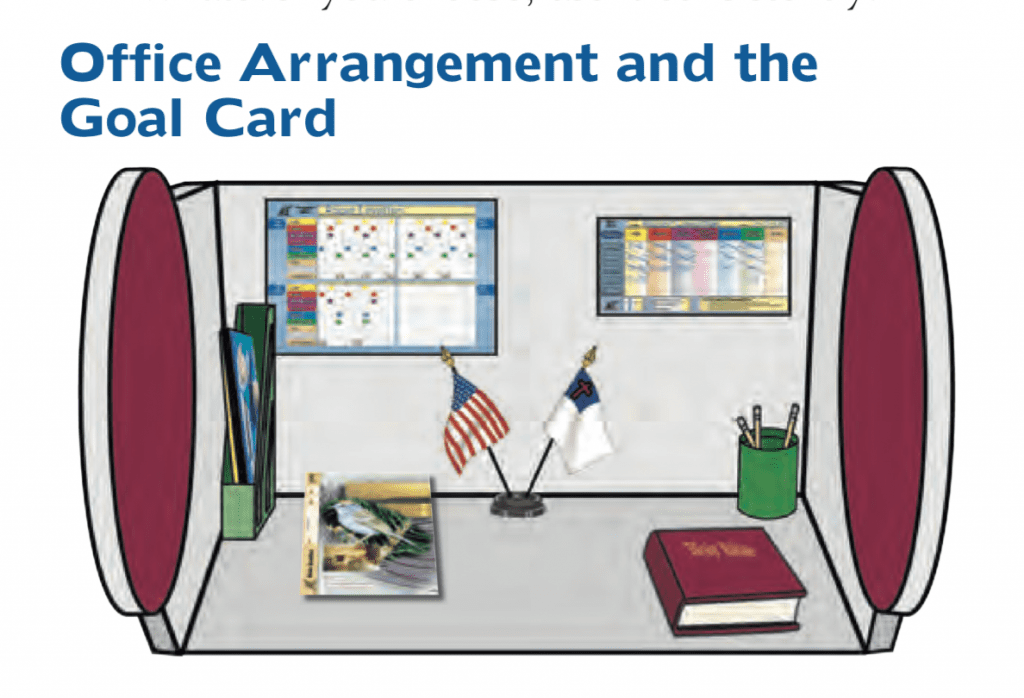I recently came upon the 2018 version of Accelerated Christian Education’s “Home Education Manual.” Accelerated Christian Education (“ACE”) originated as a Christian school curriculum in the 1970s that advertised itself as eliminating the need for teachers. Instead, children sat in cubicles working through workbooks independently. I scrolled through ACE’s Home Education Manual hoping I’d see evidence that they’ve changed their methods. Children are not meant to learn alone in cubicles. I found myself disappointed—nothing has changed. Parents don’t teach. Students receive no interactive instruction.
And children enrolled in ACE programs still sit in cubicles.
Note that they call it an “office.” They literally say: “Furnish an individual office for each student.” This is not how kids learn. Kids need a classroom with peers and a teacher, with posters and a variety of curricular materials, supplements, manipulatives and learning games, project-based learning, and so on. All of this (or at least most of it) can be provided in an in-home setting. Instead, ACE decides to replicate an office.
ACE relies primarily on a set of workbooks for each subject and grade level. They describe these workbooks as “a bite-sized booklet of curriculum” and call them PACEs (which stands for “Packet of Accelerated Christian Education”). Students work through a PACE and then take a test over the material; if they pass, they proceed to the next PACE. There are twelve PACE workbooks per subject per grade.
The student must score a minimum of 80 percent on all PACE Tests. A PACE Test score below 80 percent demonstrates inadequate learning or insufficient mastery of skills; therefore, a student who scores below 80 percent is not ready to proceed. You should order another PACE and have the student rework the entire PACE and retake the PACE Test. The original score is then replaced by the new score if it is 80 percent or higher.
Notice what parents are not told to do—they are not told to go back through concepts their children may not have understood with them. If a child fails to get 80 on a PACE Test, they must simply work through a fresh PACE book from the start and take it again.
What happens when a student has a question?
ANSWERING QUESTIONS BY ASKING QUESTIONS
The student may not be accustomed to assuming responsibility for learning nor adapted to perseverance and challenge. The normal first reaction to a difficult equation or question may be to ask for help.
I’m just going to pause here to remind the reader that the student has also not been given any instruction or an interactive learning experience. Not every 7 year old or 10 year old or 13 year old is going to learn well by doing nothing but reading and filling out workbooks. But here, the ACE manual assures parents that if their child struggles to learn completely by themselves, the problem is that the child not accustomed to assuming responsibility for their own learning. The problem is the child.
I know people who were homeschooled using either this curriculum or a similar workbook-based one and let me just say, it did not go well. It should not be surprising that turning school into a self-isolation office space would kill children’s love of learning. Beyond this, curriculum programs that require children to simply regurgitate information, and not to engage in creative solutions or independent thinking, mean that children never really engage in learning in the first place—only in memorization.
Learning is the student’s responsibility, and information and skill building are in his PACE.
Oh my god. What did I just say!
You are a leader and an inspirer of learning. Most of the time the student’s problem is lack of interest or confidence. Your greatest responsibility and most important function is exercised in these cases. Words of confidence, encouragement, reassurance, and sincere personal interest provide the plus factors.
Remember, they’re telling parents that they are “a leader” and “an inspirer of learning” because the whole program is based on the idea that this system eliminates the need for teaching. Parents don’t need to provide instruction. They aren’t a teacher. Their role is to inspire their child.
Opportunities for motivation come, especially when a student has an academic activity that demands additional help.
When a student calls for academic assistance, ask leading questions that focus the student’s attention on the solution. If the question is immediately answered, his mental inquiry may stop short of a learning experience. You should not answer the PACE questions but determine the nature of the problem and help the student find the answer.
If the student realizes he can get his questions answered without having to work at it, he will become lazy and resort to asking for help rather than taking responsibility to master the activity himself.
It is absolutely true that you shouldn’t give a child the answer when they ask for help. It is absolutely true that you should help the student arrive at the answer themselves. However. Doing that well involves knowing the subject matter yourself, which is something the ACE manual insists you don’t need to do. Also, this focus on finding the right answer is itself odd. For ACE, it matters less whether the child has a good conceptual understanding of the subject matter than whether she is able to find the right answer.
The strength of the Accelerated Christian Education curriculum is in its design, which allows a student to learn independently of your academic knowledge of subject matter. Your greatest joy is realized as the student matures toward less and less dependence on you.
The A.C.E. curriculum is designed to facilitate learning rather than teaching. You will become adept at assisting students in digging out answers and gaining insights into learning how to learn.
I wasn’t being over the top when I said the program is designed to eliminate the need for teachers. It’s also designed to eliminate the need for teaching. They say this explicitly! The goal is to get to a place where the student doesn’t have to even ask the parent for help. The child, ideally, should be completely on their own.
I get that we want kids to become independent learners. Absolutely! But that’s not really what this is about. Independent learners, at least in our regular understanding, are given tools and encouraged to engage in creative thinking and problem solving that is about more than finding the “right” answer. This is not that at all. This curriculum is made up of nothing but workbooks with fill in the blank answers.
There’s a whole section labeled “Tips for Achieving Higher Test Scores.” Most of this section involves things like good nutrition and minimizing distractions—but I have to wonder, why is the focus on test scores in the first place? Sure, yes, public schools are often too focused on test scores—amen and absolutely—but even there there are screenings like the MAP that are conceptual in nature, and are designed to let the teacher know what the child needs more work on. In ACE, test scores only signal whether the child can move on to the next workbook, completely alone, absent any teacher or peers to learn from.
In fact, in the ACE program, test scores don’t even signal whether the child has grasped the concepts or materials. They only assess whether the child is able to provide the correct answers. It is often possible to plug in correct answers without actually understanding the underlying framework or the fundamental concepts. This is made clear by one of the manual’s recommendations for “achieving high test scores”:
Make sure the student knows and memorizes important vocabulary, definitions, and math/science formulas.
Having formulas memorized does not mean you understand the concepts. In fact, it often means the opposite. Relying on memorized formulas suggests a shallow understanding of the underlying concepts.
The idea that you could do away with the need for interactive instruction or peer interaction is baffling to me. Remember, this program was initially developed not for homeschools but for Christian schools being run out of church basements after white parents abandoned public schools in the wake of school integration. And their solution was to put children in individual cubicles and nix the need for peer interaction entirely.
I don’t think this means what they think it means.
I have a Patreon! Please support my writing!



















